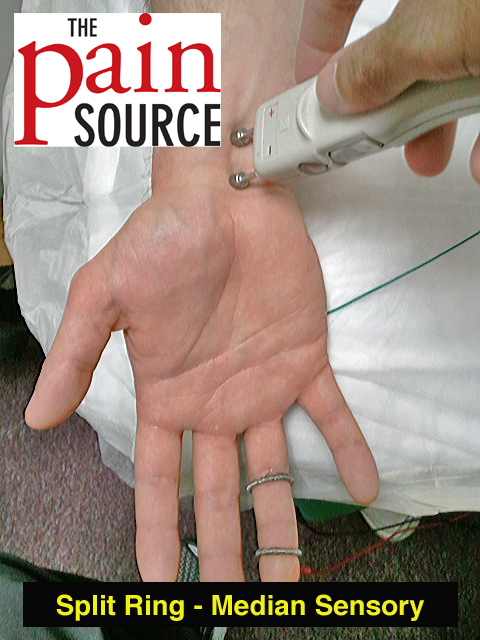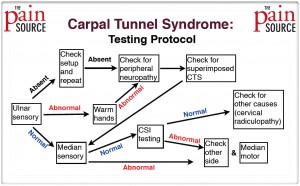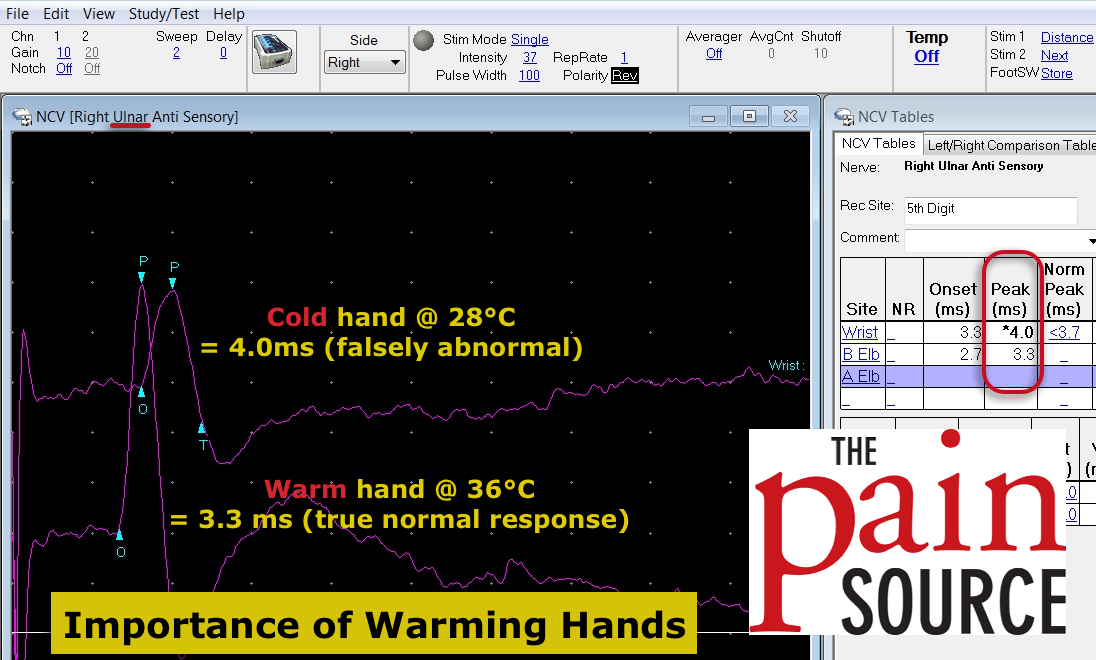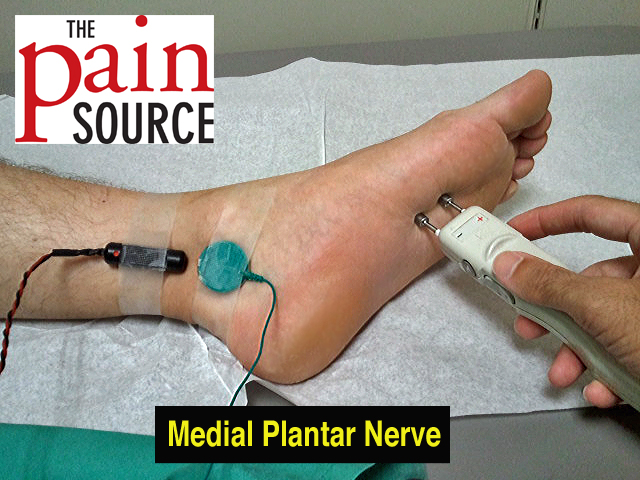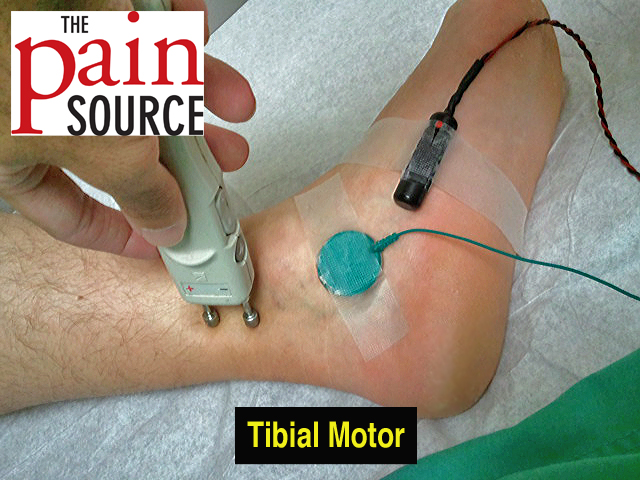By Chris Faubel, MD —
**This post will focus only on the electrodiagnostic information relevant to the diagnosis of carpal tunnel syndrome (CTS).
**For a more detailed review of carpal tunnel syndrome, click here.
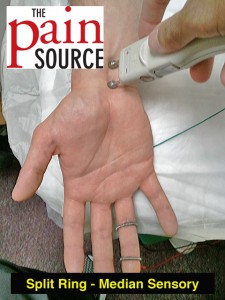
Nerve Conduction Studies (NCS)
–
Median Sensory NCS
- Median sensory and motor NCS: Sensitivity = 85%; Specificity = 95% [5]
- Most sensitive digit for detecting early/mild CTS = digit 4 (88%) [1]
- Digit 1, digit 2, and digit 3 was 61%, 22%, and 50%, respectively.
- For details on how to set up and perform a median sensory NCS, click here.
Combined Sensory Index (CSI)
- For a detailed description of the CSI, click here
- In short, the CSI is composed of the three separate tests (summation of their latency differences): CSI >0.9 = positive
- Numb thumb (median/radial)
- Split ring (median/ulnar)
- P8 (median/ulnar)
- Superior sensitivity and specificity for diagnosing CTS (better than the typical median sensory across the wrist)
- The CSI is more reliable than either component test alone (ie. excellent test-retest reliability) [2]
- When to perform the CSI [3]
- A study looked at the cutoff points in which a component test’s particular difference meant the combined testing (CSI) would either be always positive or always negative.
For instance:- Ring difference
- >0.4ms, the CSI will always be positive, so there is no reason to proceed with the other parts.
- <0.2ms = CSI always negative→ NO CTS
- Thumb difference
- >0.5ms = CSI always ends up being positive
- <0.3ms = CSI always negative
- P8 difference
- >0.3ms, the CSI is also always positive, so stop.
- <0.1ms = CSI always negative, so stop
- Ring difference
- Recommended steps to follow: Ring → Thumb → P8
- If the above thresholds (either high or low) are met, stop the testing and diagnose (or rule out) CTS
- If the ring difference is in-between the ranges, proceed to the thumb, and then the P8.
- A study looked at the cutoff points in which a component test’s particular difference meant the combined testing (CSI) would either be always positive or always negative.
Median Motor NCS
- For details on how to set up and perform a median motor NCS, click here.
- Used to calculate the median nerve conduction velocity, and grade the severity of the CTS.
- Conduction Velocity
- Forearm conduction velocity may be mildly slowed because of retrograde axonal atrophy [6]
Grading the Severity (of electrodiagnostically-confirmed CTS)
- Negative = Normal findings on all tests
- Borderline mild = Abnormal findings only on CSI tests (an individual test or the collective CSI)
- Mild = Slow median sensory with normal distal motor latency
- Moderate = Slow median sensory AND distal motor latencies
- Severe = Absent sensory and increased motor latency
- Profoundly severe = Absent sensory and motor response
- Severity of symptoms vs NCS findings
- No statistically significant relationship between the severity of symptoms a patient has, and the severity of electrodiagnostic findings. [40]
CTS Testing Protocol
Electromyography (EMG)
- Usually performed on the abductor pollicis brevis (APB) muscle in the thenar eminence.
- Used to evaluate for axonal degeneration of the motor fibers in the median nerve (will see positive sharp waves and fibrillations)
- Should you perform needle EMG for the diagnosis of CTS? Not if the purpose is to grade the severity of the CTS.
- Severity of EMG findings in the APB correlates well with the severity of motor NCS [4]
- Needle EMG does not provide any further information about the CTS [4]
- So save the patient the additional pain and just stick with the sensory and motor NCS for both diagnosing and grading the severity.
- When is needle EMG warranted?
- When other diagnoses are suspected; such as cervical radiculopathy, brachial plexitis, other entrapment neuropathy.
————————————————————————————-
REFERENCES:
1 – Terzis et al. “Early diagnosis of carpal tunnel syndrome: comparison of sensory conduction studies of four fingers.” Muscle Nerve. 1998 Nov;21(11):1543-5
2 – Lew et al. “Test-retest reliability of combined sensory index: implications for diagnosing carpal tunnel syndrome.” Muscle Nerve. 2000 Aug;23(8):1261-4
3 – Kaul et al. “When to use the combined sensory index.” Muscle Nerve. 2001 Aug;24(8):1078-82
4 – Wee AS. “Needle electromyography in carpal tunnel syndrome.” Electromyography & Clinical Neurophysiology. 2002 Jun;42(4):253-6
5 – [Guideline] Jablecki CK, Andary MT, Floeter MK, Miller RG, Quartly CA, Vennix MJ, et al. Practice parameter: Electrodiagnostic studies in carpal tunnel syndrome. Report of the American Association of Electrodiagnostic Medicine, American Academy of Neurology, and the American Academy of Physical Medicine and Rehabilitation. Neurology. Jun 11 2002;58(11):1589-92.
6 – Chang et al. “The cause of slowed forearm median conduction velocity in carpal tunnel syndrome: a Palmar stimulation study.” Clin Neurophysiol. 2002 Jul;113(7):1072-6

